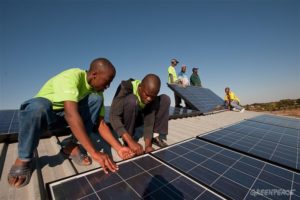
“We’ve pushed them to be better,” says Jasandra Nyker, chief executive of BioTherm Energy Ltd., a South African solar and wind power producer.
A short learning curve is particularly critical for South Africa, where economic growth has stalled as state power company Eskom Holdings SOC Ltd. races to modernize aging power plants and transmission lines whose frequent breakdowns are regularly leaving the country in the dark.
“The increased grid-capacity requirements coupled with intermittent generation inherent in renewable sources of energy requires Eskom to strategically strengthen the grid,” says Dikatso Mothae, a spokeswoman for the power company.
To get its grid up to speed, Eskom has spent $180 million upgrading its network of transmission stations and strung hundreds of miles of high-voltage power lines to more than 40 private wind and solar plants.
From desert to city
About 4% of South Africa’s 43,000 megawatts of generating capacity comes from renewable sources. The government wants to triple the total to some 6,000 megawatts by 2020.
South Africa is one of the richest countries in the world when it comes to renewable potential, from the blustery Atlantic Coast around Cape Town to the sun-drenched fringes of the Kalahari Desert. The country’s sunniest stretches receive more than twice the annual solar radiation that reaches Northern Europe, where solar power has gained popularity in recent years.
But South Africa’s sunniest province, the Northern Cape, is 500 miles from Johannesburg, the country’s economic engine and top energy consumer. Getting solar energy from the desert to customers in the city is the biggest challenge facing Eskom.
Read more at wsj.com


